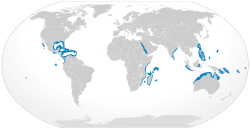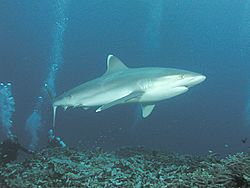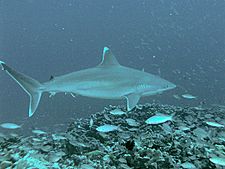Silvertip shark facts for kids
Quick facts for kids Silvertip shark |
|
|---|---|
 |
|
| Conservation status | |
| Scientific classification | |
| Kingdom: | |
| Class: | |
| Order: | |
| Family: | |
| Genus: | |
| Binomial name | |
| Carcharhinus albimarginatus |
|
 |
|
| Range of the silvertip shark | |
The silvertip shark (Carcharhinus albimarginatus), is a large species of requiem shark, family Carcharhinidae, found in the Indian and Pacific Ocean. This shark has white tips on its fins. With an average length of 2-2.5 metres, the silvertip shark rarely reaches the length of 3 meters.
Contents
Description
The silvertip shark is slender with a long and broadly rounded snout. The eyes are large and round. An interdorsal ridge is present on this species. The first dorsal fin is large with a pointed apex. It originates over or slightly in front of the free tips of the pectoral fins. The second dorsal fin originates over or just behind the origin of the anal fin. The pectoral fins are large and semifalcate with narrowly rounded or pointed tips. The caudal fin is asymmetrical in shape with a rather large upper lobe. The top of the body is dark grey or grey-brown with a bronzy sheen, and the underside is white. A white band, which is not clearly visible, is on its flank.
The silvertip shark may be confused with the grey reef shark (Carcharhinus amblyrhynchos), but the grey reef shark has dark tips on the pectoral fins and trailing edge of the caudal fin. Also, the whitetip reef shark (Triaenodon obesus) is similar in appearance to the silvertip shark. Although both shark species have white markings on the dorsal and caudal fins, the whitetip reef shark doesn't have these markings on the tips of the pectoral fins. The whitetip reef shark also has a more square-shaped snout. The silvertip shark has 12-14 teeth on each jaw. The upper teeth are broad and strongly jagged.
Habitat
Silvertip sharks are found over continental and island shelves and offshore banks. They prefer offshore islands, coral reefs and banks to depths of 800 m. They are common in tropical oceans.
They have been found in the western Indian Ocean: the Red Sea and of East Africa, including Madagascar, Seychelles, Aldabra Group, Mauritius and the Chagos Archipelago. In the western Pacific they are found off southern Japan to northern Australia and French Polynesia. In the eastern central Pacific they are found off southern Baja California, Mexico to Colombia, including the Cocos, Galápagos, and Revillagigedo Islands.
Behaviour
This shark is a great hunter and is very stealthy. They are usually found in shallow waters, making them one of the most commonly seen sharks. Its unpredictable behaviour and aggressive hunting tactics make it a higher threat to humans than most other sharks.
Feeding

Prey of the silvertip shark include benthic and midwater fish such as wahoo, eagle rays, wrasses, and tunas as well as small sharks. This shark also feeds on octopuses and squid. The silvertip shark has been observed swimming along the edge of a group of other species of feeding sharks, taking food from them.
Reproduction
The silvertip shark is viviparous, meaning that they give live birth. Courtship is a little different in these sharks and they are known to hold each other. Bites are normal, so much so that a female Silvertip shark has been found without a part of the dorsal fin after mating. Mating occurs in the summer. During the gestation period that could extend to a year, the embryos feed from the yolk and once the yolk is exhausted, the yolk-sac modifies itself into a placental connection through which the newborns feed from the mother.
The newborns are born in litters (normally 5 to 6 but can be from 1 to 11) and are anywhere between 63 to 81 centimeters or 25 to 32 inches long. The females are considered sexually mature once they grow to be about 2 meters long and in the case of males, it is 1.8 meters. The pups are known to swim with the mother shark in shallow waters before becoming independent.
Human interaction
Silvertip sharks are somewhat dangerous. According to the International Shark Attack File (ISAF), there have been four unprovoked attacks by this species on humans, with no deaths. Arguably, humans are much more dangerous to the shark. Silvertips are caught by commercial and artisan fisheries across their range using longlines, gillnets, and trawls, both intentionally and as bycatch. Their fins are highly valued for shark-fin soup and are sold on the export market, along with their skin and cartilage. This species is vulnerable to overfishing (like almost all sharks) due to its slow reproductive rate. The IUCN has listed the silvertip shark as near threatened, and has noted that it may be approaching the criteria for vulnerable.
The silvertip shark is caught by fisheries in Indonesia, Myanmar and the Philippines. In the Philippines, it is in the top ten most caught species by number (0.73%), and weight (2.6%), with individuals ranging in size from 2.1-2.4 metres, and averaging 23 kg in weight.
Images for kids
See also
 In Spanish: Tiburón de punta plateada para niños
In Spanish: Tiburón de punta plateada para niños








